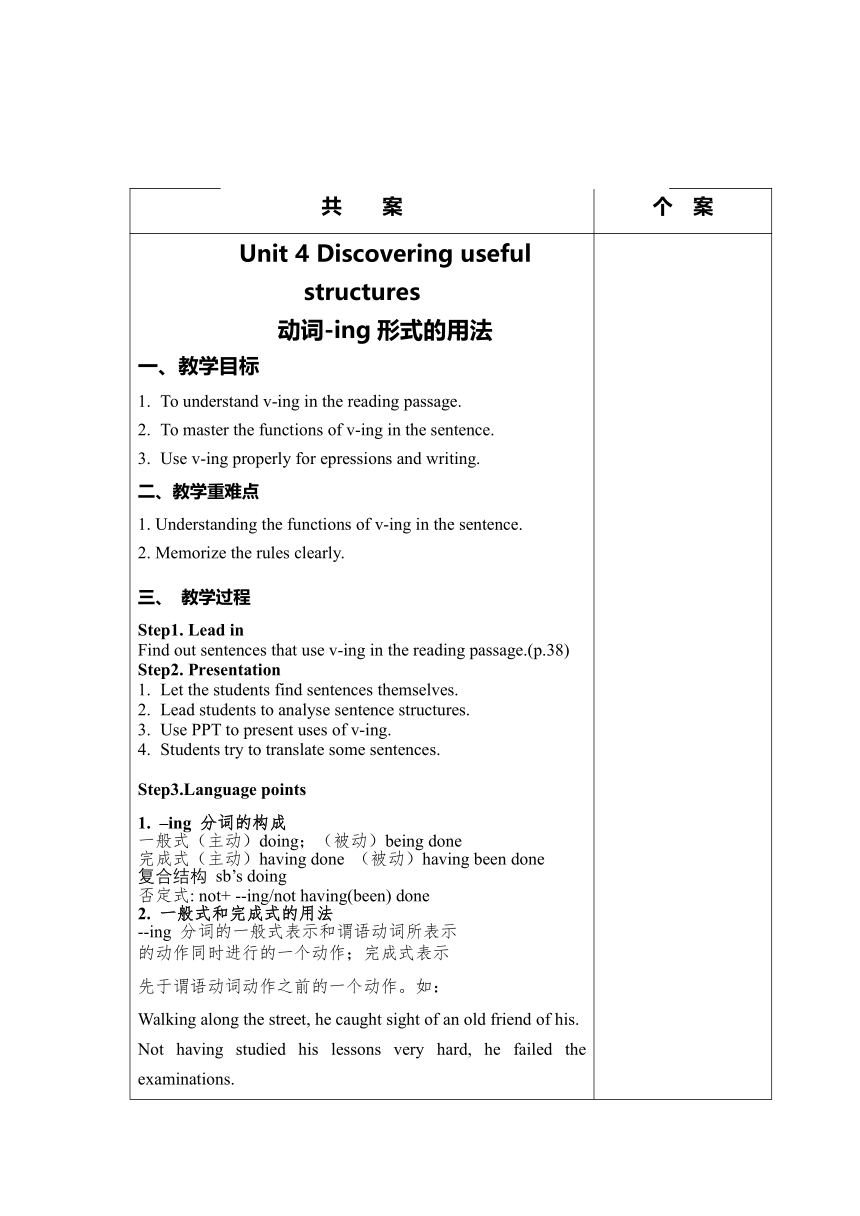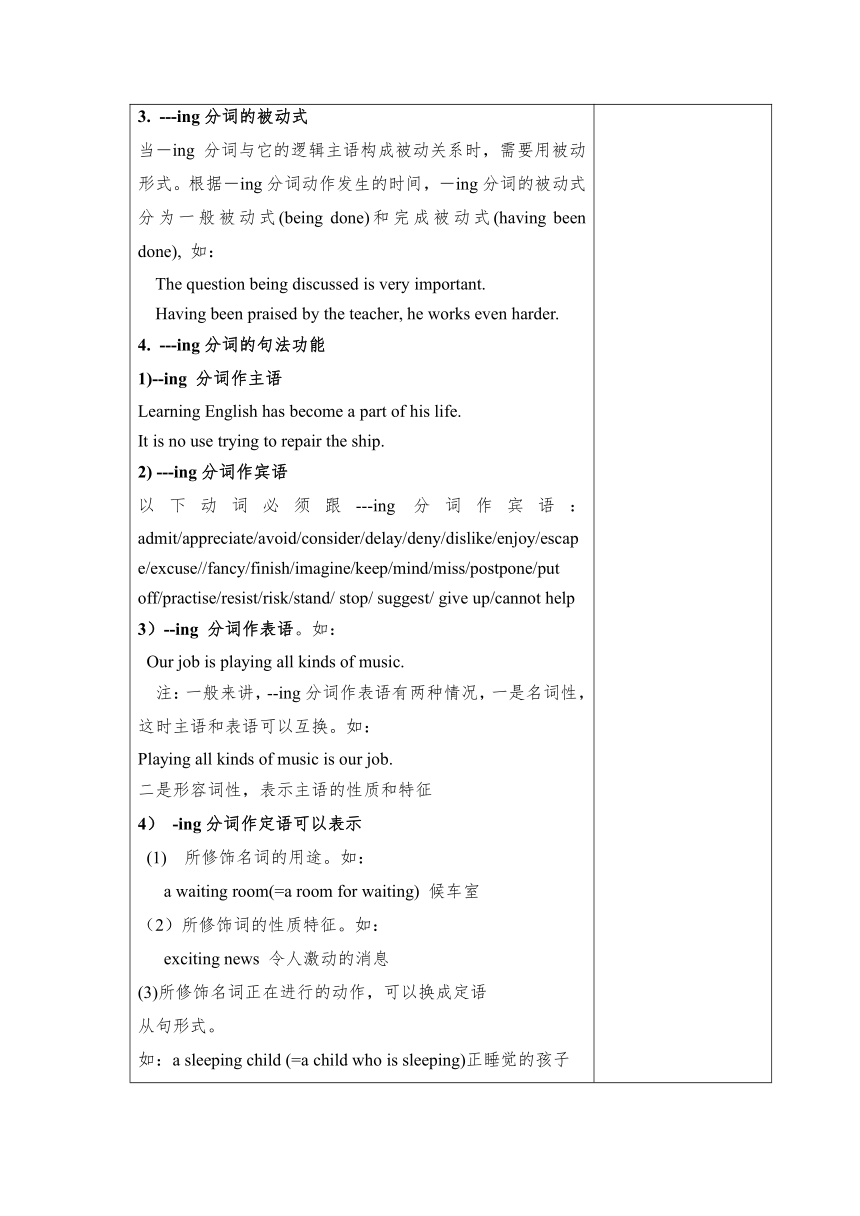人教版(2019)选择性必修第一册:Unit 4 Body Language 语法教案(表格式)
文档属性
| 名称 | 人教版(2019)选择性必修第一册:Unit 4 Body Language 语法教案(表格式) |

|
|
| 格式 | docx | ||
| 文件大小 | 25.0KB | ||
| 资源类型 | 教案 | ||
| 版本资源 | 人教版(2019) | ||
| 科目 | 英语 | ||
| 更新时间 | 2022-03-10 12:48:23 | ||
图片预览


文档简介
共 案 个 案
Unit 4 Discovering useful structures 动词-ing形式的用法 教学目标 To understand v-ing in the reading passage. To master the functions of v-ing in the sentence. Use v-ing properly for epressions and writing. 二、教学重难点 1. Understanding the functions of v-ing in the sentence. 2. Memorize the rules clearly. 三、 教学过程 Step1. Lead in Find out sentences that use v-ing in the reading passage.(p.38) Step2. Presentation Let the students find sentences themselves. Lead students to analyse sentence structures. Use PPT to present uses of v-ing. Students try to translate some sentences. Step3.Language points –ing 分词的构成 一般式(主动)doing;(被动)being done 完成式(主动)having done (被动)having been done 复合结构 sb’s doing 否定式: not+ --ing/not having(been) done 一般式和完成式的用法 --ing 分词的一般式表示和谓语动词所表示 的动作同时进行的一个动作;完成式表示 先于谓语动词动作之前的一个动作。如: Walking along the street, he caught sight of an old friend of his. Not having studied his lessons very hard, he failed the examinations. ---ing分词的被动式 当-ing 分词与它的逻辑主语构成被动关系时,需要用被动形式。根据-ing分词动作发生的时间,-ing分词的被动式分为一般被动式(being done)和完成被动式(having been done), 如: The question being discussed is very important. Having been praised by the teacher, he works even harder. ---ing分词的句法功能 1)--ing 分词作主语 Learning English has become a part of his life. It is no use trying to repair the ship. 2) ---ing分词作宾语 以下动词必须跟---ing分词作宾语:admit/appreciate/avoid/consider/delay/deny/dislike/enjoy/escape/excuse//fancy/finish/imagine/keep/mind/miss/postpone/put off/practise/resist/risk/stand/ stop/ suggest/ give up/cannot help 3)--ing 分词作表语。如: Our job is playing all kinds of music. 注:一般来讲,--ing分词作表语有两种情况,一是名词性,这时主语和表语可以互换。如: Playing all kinds of music is our job. 二是形容词性,表示主语的性质和特征 4) -ing分词作定语可以表示 (1) 所修饰名词的用途。如: a waiting room(=a room for waiting) 候车室 (2)所修饰词的性质特征。如: exciting news 令人激动的消息 (3)所修饰名词正在进行的动作,可以换成定语 从句形式。 如:a sleeping child (=a child who is sleeping)正睡觉的孩子 注:分词短语作定语须放在所修饰词之后,例如:the man standing at the gate=the man who is standing at the gate 5) 在see,hear,feel,watch,notice等感官动词后可以用-ing形式做宾语补足语。这时-ing 形式和句子的宾语之间存在着逻辑上的主谓关系,并且-ing 形式表示宾语正在进行的动作。如: He saw a boy climbing the tree. Do you hear someone knocking at the door 有人敲门你听见了吗 6)-ing分词作状语 (1)-ing分词在句中可以作伴随状语,常放于句后,表示主语正在进行的另一个动作,来对谓语表示的主要动作加以修饰或作主要陪衬。如:They sat in front of the building, laughing and chatting. He worked late yesterday, preparing for the lecture. (2)-ing分词可以作时间状语,常放在句首,如: (While)Walking in the street,I caught sight of a tailor's shop. (3)-ing分词可以作原因状语,常放句首。 如:Being ill, he can't go to school. (4)-ing分词可以作条件状语,常放句首。 Turning to the right, you’ll find the post office there. (5)-ing分词可以作结果状语,常放句末。 He turned off the light, seeing nothing. 5. -ing分词的复合结构 物主代词/人称代词/名词所属格或普通名词+ing分词 (1) 作主语(须用物主代词或名词所属格) His/Tom’s not being chosen made us disappointed. (2)作宾语(除了物主代词和名词所有格,也可用普通名词或代词宾格) He was awakened by someone’s knocking at the door. (3)作状语 (须用普通名词或主格代词,亦称 独立主格结构) Time permitting, we’ll deal with the text. 教后反思(不少于100字)
Unit 4 Discovering useful structures 动词-ing形式的用法 教学目标 To understand v-ing in the reading passage. To master the functions of v-ing in the sentence. Use v-ing properly for epressions and writing. 二、教学重难点 1. Understanding the functions of v-ing in the sentence. 2. Memorize the rules clearly. 三、 教学过程 Step1. Lead in Find out sentences that use v-ing in the reading passage.(p.38) Step2. Presentation Let the students find sentences themselves. Lead students to analyse sentence structures. Use PPT to present uses of v-ing. Students try to translate some sentences. Step3.Language points –ing 分词的构成 一般式(主动)doing;(被动)being done 完成式(主动)having done (被动)having been done 复合结构 sb’s doing 否定式: not+ --ing/not having(been) done 一般式和完成式的用法 --ing 分词的一般式表示和谓语动词所表示 的动作同时进行的一个动作;完成式表示 先于谓语动词动作之前的一个动作。如: Walking along the street, he caught sight of an old friend of his. Not having studied his lessons very hard, he failed the examinations. ---ing分词的被动式 当-ing 分词与它的逻辑主语构成被动关系时,需要用被动形式。根据-ing分词动作发生的时间,-ing分词的被动式分为一般被动式(being done)和完成被动式(having been done), 如: The question being discussed is very important. Having been praised by the teacher, he works even harder. ---ing分词的句法功能 1)--ing 分词作主语 Learning English has become a part of his life. It is no use trying to repair the ship. 2) ---ing分词作宾语 以下动词必须跟---ing分词作宾语:admit/appreciate/avoid/consider/delay/deny/dislike/enjoy/escape/excuse//fancy/finish/imagine/keep/mind/miss/postpone/put off/practise/resist/risk/stand/ stop/ suggest/ give up/cannot help 3)--ing 分词作表语。如: Our job is playing all kinds of music. 注:一般来讲,--ing分词作表语有两种情况,一是名词性,这时主语和表语可以互换。如: Playing all kinds of music is our job. 二是形容词性,表示主语的性质和特征 4) -ing分词作定语可以表示 (1) 所修饰名词的用途。如: a waiting room(=a room for waiting) 候车室 (2)所修饰词的性质特征。如: exciting news 令人激动的消息 (3)所修饰名词正在进行的动作,可以换成定语 从句形式。 如:a sleeping child (=a child who is sleeping)正睡觉的孩子 注:分词短语作定语须放在所修饰词之后,例如:the man standing at the gate=the man who is standing at the gate 5) 在see,hear,feel,watch,notice等感官动词后可以用-ing形式做宾语补足语。这时-ing 形式和句子的宾语之间存在着逻辑上的主谓关系,并且-ing 形式表示宾语正在进行的动作。如: He saw a boy climbing the tree. Do you hear someone knocking at the door 有人敲门你听见了吗 6)-ing分词作状语 (1)-ing分词在句中可以作伴随状语,常放于句后,表示主语正在进行的另一个动作,来对谓语表示的主要动作加以修饰或作主要陪衬。如:They sat in front of the building, laughing and chatting. He worked late yesterday, preparing for the lecture. (2)-ing分词可以作时间状语,常放在句首,如: (While)Walking in the street,I caught sight of a tailor's shop. (3)-ing分词可以作原因状语,常放句首。 如:Being ill, he can't go to school. (4)-ing分词可以作条件状语,常放句首。 Turning to the right, you’ll find the post office there. (5)-ing分词可以作结果状语,常放句末。 He turned off the light, seeing nothing. 5. -ing分词的复合结构 物主代词/人称代词/名词所属格或普通名词+ing分词 (1) 作主语(须用物主代词或名词所属格) His/Tom’s not being chosen made us disappointed. (2)作宾语(除了物主代词和名词所有格,也可用普通名词或代词宾格) He was awakened by someone’s knocking at the door. (3)作状语 (须用普通名词或主格代词,亦称 独立主格结构) Time permitting, we’ll deal with the text. 教后反思(不少于100字)
